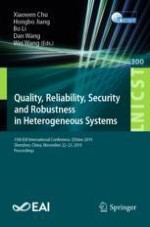2020 | Buch
Quality, Reliability, Security and Robustness in Heterogeneous Systems
15th EAI International Conference, QShine 2019, Shenzhen, China, November 22–23, 2019, Proceedings
herausgegeben von: Xiaowen Chu, Hongbo Jiang, Bo Li, Dr. Dan Wang, Assist. Prof. Wei Wang
Verlag: Springer International Publishing
Buchreihe : Lecture Notes of the Institute for Computer Sciences, Social Informatics and Telecommunications Engineering
